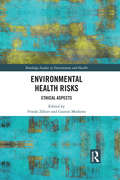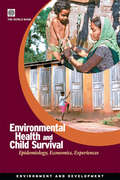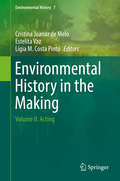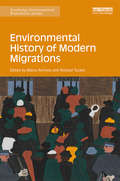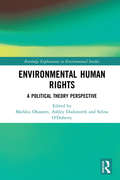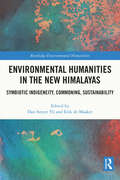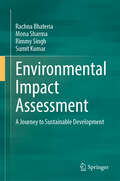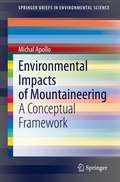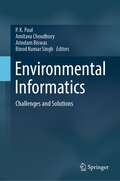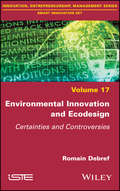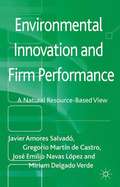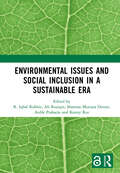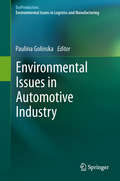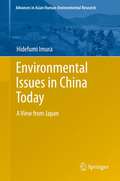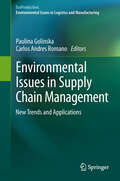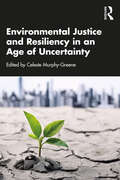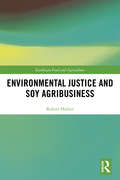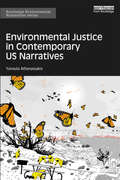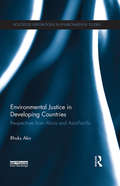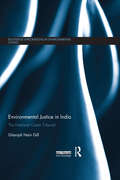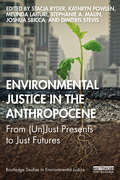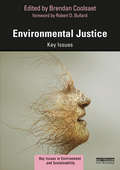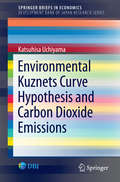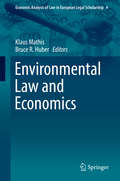- Table View
- List View
Environmental Health Risks: Ethical Aspects (Routledge Studies in Environment and Health)
by Friedo Zölzer Gaston MeskensEnvironmental health involves the assessment and control of environmental factors that can potentially affect human health, such as radiation, toxic chemicals and other hazardous agents. It is less commonly understood that environmental health also requires addressing questions of an ethical nature. Bringing together work from experts across a range of sub-disciplines of environmental health, this collection of essays discusses the ethical implications of environmental health research and its application, presented at the 3rd International Symposium on Ethics of Environmental Health held in August 2016 in the Czech Republic. In doing so, it builds upon the insights and ideas put forward in the first volume of Ethics of Environmental Health, published by Routledge in early 2017. This volume will be of great interest to students and scholars of environmental health, applied ethics, environmental ethics, medical ethics and bioethics, as well as those concerned with public health, environmental studies, toxicology and radiation.
Environmental Health and Child Survival
by World BankEach year, millions of children in developing countries fall sick and die from diseases caused by polluted air, contaminated water and soil, and poor hygiene behavior. Repeated infectious also contribute to malnutrition in children, and subsequently impacts future learning and productivity. This book analyzes the linkages between malnutrition and environmental health, and assesses the burden of disease on young children, and its economic costs.
Environmental History in the Making
by Estelita Vaz Cristina Joanaz de Melo Lígia M. Costa PintoThis book is the product of the 2nd World Conference on Environmental History, held in Guimar#65533;es, Portugal, in 2014. It gathers works by authors from the five continents, addressing concerns raised by past events so as to provide information to help manage the present and the future. It reveals how our cultural background and examples of past territorial intervention can help to combat political and cultural limitations through the common language of environmental benefits without disguising harmful past human interventions. Considering that political ideologies such as socialism and capitalism, as well as religion, fail to offer global paradigms for common ground, an environmentally positive discourse instead of an ecological determinism might serve as an umbrella common language to overcome blocking factors, real or invented, and avoid repeating ecological loss. Therefore, agency, environmental speech and historical research are urgently needed in order to sustain environmental paradigms and overcome political, cultural an economic interests in the public arena. This book intertwines reflections on our bonds with landscapes, processes of natural and scientific transfer across the globe, the changing of ecosystems, the way in which scientific knowledge has historically both accelerated destruction and allowed a better distribution of vital resources or as it, in today's world, can offer alternatives that avoid harming those same vital natural resources: water, soil and air. In addition, it shows the relevance of cultural factors both in the taming of nature in favor of human comfort and in the role of the environment matters in the forging of cultural identities, which cannot be detached from technical intervention in the world. In short, the book firstly studies the past, approaching it as a data set of how the environment has shaped culture, secondly seeks to understand the present, and thirdly assesses future perspectives: what to keep, what to change, and what to dream anew, considering that conventional solutions have not sufficed to protect life on our planet.
Environmental History of Modern Migrations (Routledge Environmental Humanities)
by Marco Armiero Richard TuckerIn the age of climate change, the possibility that dramatic environmental transformations might cause the dislocation of millions of people has become not only a matter for scientific speculation or science-fiction narratives, but the object of strategic planning and military analysis. Environmental History of Modern Migrations offers a worldwide perspective on the history of migrations throughout the nineteenth and twentieth centuries and provides an opportunity to reflect on the global ecological transformations and developments which have occurred throughout the last few centuries. With a primary focus on the environment/migration nexus, this book advocates that global environmental changes are not distinct from global social transformations. Instead, it offers a progressive method of combining environmental and social history, which manages to both encompass and transcend current approaches to environmental justice issues. This edited collection will be of great interest to students and practitioners of environmental history and migration studies, as well as those with an interest in history and sociology.
Environmental Human Rights: A Political Theory Perspective (Routledge Explorations in Environmental Studies)
by Markku Oksanen Ashley Dodsworth Selina O'DohertyThe nature of environmental human rights and their relation to larger rights theories has been a frequent topic of discussion in law, environmental ethics and political theory. However, the subject of environmental human rights has not been fully established among other human rights concerns within political philosophy and theory. In examining environmental rights from a political theory perspective, this book explores an aspect of environmental human rights that has received less attention within the literature. In linking the constraints of political reality with a focus on the theoretical underpinnings of how we think about politics, this book explores how environmental human rights must respond to the key questions of politics, such as the state and sovereignty, equality, recognition and representation, and examines how the competing understandings about these rights are also related to political ideologies. Drawing together contributions from a range of key thinkers in the field, this is a valuable resource for students and scholars of human rights, environmental ethics, and international environmental law and politics more generally.
Environmental Humanities in the New Himalayas: Symbiotic Indigeneity, Commoning, Sustainability (Routledge Environmental Humanities)
by Erik De Maaker Dan Smyer YüEnvironmental Humanities in the New Himalayas: Symbiotic Indigeneity, Commoning, Sustainability showcases how the eco-geological creativity of the earth is integrally woven into the landforms, cultures, and cosmovisions of modern Himalayan communities. Unique in scope, this book features case studies from Bhutan, Assam, Sikkim, Tibet, Nepal, Pakistan, and Sino-Indian borderlands, many of which are documented by authors from indigenous Himalayan communities. It explores three environmental characteristics of modern Himalayas: the anthropogenic, the indigenous, and the animist. Focusing on the sentient relations of human-, animal-, and spirit-worlds with the earth in different parts of the Himalayas, the authors present the complex meanings of indigeneity, commoning and sustainability in the Anthropocene. In doing so, they show the vital role that indigenous stories and perspectives play in building new regional and planetary environmental ethics for a sustainable future. Drawing on a wide range of expert contributions from the natural sciences, social sciences, and humanist disciplines, this book will be of great interest to students and scholars of environmental humanities, religion and ecology, indigenous knowledge and sustainable development more broadly.
Environmental Impact Assessment: A Journey to Sustainable Development
by Mona Sharma Sumit Kumar Rachna Bhateria Rimmy SinghThis book will cover the basic principles and salient features of EIA. The authors attempt to cover the shortcomings observed in EIA reports, the manner of conducting EIA for proposed projects, and also to facilitate the preparation of good quality EIA reports. The book is written in a straightforward format avoiding long descriptive texts to enhance the reader experience Although the focus is on the Indian context, the concepts and techniques of EIA described in this book are applicable universally. An Environmental Management Plan (EMP) is also discussed, and this is an essential aspect of EIA in countries where priority is on economic development by way of development projects and when the EIA process has inherent weaknesses. For the continual improvement of EIA reports, EIA consultants maybe assigned the task of implementing and operationalizing the suggested EMP in addition to conducting an EIA study and in preparation of an EIA report. The system of peer review of EIA reports is also expected to improve EIA quality. “Environmental Impact Assessment: A Journey to Sustainable Development” is an attempt to cover EIA according to new knowledge acquired through research and experiences which will make this tool more versatile and dynamic. The authors recognise that since EIA is continuously expanding and developing there will always be potential for improving the scope of this book to make it more useful to the users as per their requirement. This book will be of interest to academics, EIA professionals and consultants, EIA review/appraisal authorities and particularly stakeholders in emerging economies where major developmental work is being undertaken and which is expected to continue in decades to come.
Environmental Impacts of Mountaineering: A Conceptual Framework (SpringerBriefs in Environmental Science)
by Michal ApolloThis book investigates the consequences of mountaineering (hiking, trekking, climbing) on the natural environment. These consequences are divided into three groups: 1) transformations caused by the mountaineer’s, or other people’s, stay in a mountaineering region; 2) transformations caused by the mountaineer’s travel (movement) through a mountaineering region, with the consideration of the ground type (rock, rock and grass, grass, residual soil, snow, ice), and 3) transformations caused by the use of mountaineering equipment. Each of the three groups are examined individually for their direct interference with the environment, i.e. caused by the main activities of climbing, trekking and hiking (both for elite and mass mountaineering) and their indirect interference caused by auxiliary activity (mainly in the case of mass mountaineering). Auxiliary activity includes guide services, transport of equipment, use of base camp facilities and the delivery of artificial support equipment, and supports the main activity. The consequences of mountaineering on the natural environment are characterized in terms of individual components of the environment (land relief, soil, vegetation, fauna, and landscape) and location/zone of mountaineering activity (hiking, trekking or climbing zone). Because of the connections and interdependence between particular components of the environment (biotic and abiotic), only preservation of each of them can bring the desired effect – a reduction in the negative impact of mountaineering. This book presents comprehensive research outcomes and serves as a platform for more detailed, future studies.
Environmental Informatics: Challenges and Solutions
by Arindam Biswas Amitava Choudhury P. K. Paul Binod Kumar SinghThis interdisciplinary book incorporates various aspects of environment, ecology, and natural disaster management including cognitive informatics and computing. It fosters research innovation and discovery on basic science and information technology for addressing various environmental problems, while providing the right solutions in environment, ecology, and disaster management. This book is a unique resource for researchers and practitioners of energy informatics in various scientific, technological, engineering, and social fields to disseminate original research on the application of digital technology and information management theory and practice to facilitate the global transition toward sustainable and resilient energy systems. Cognitive informatics is also the need of the hour and deals with cutting-edge and multidisciplinary research area that tackles the fundamental problems shared by modern informatics, computation, software engineering, AI, cybernetics, cognitive science, neuropsychology, medical science, systems science, philosophy, linguistics, economics, management science, and life sciences, which this book also presents.
Environmental Infrastructure in African History
by Emmanuel KreikeEnvironmental Infrastructure in African History offers a new approach for analyzing and narrating environmental change. Environmental change conventionally is understood as occurring in a linear fashion, moving from a state of more nature to a state of less nature and more culture. In this model, non-Western and premodern societies live off natural resources, whereas more modern societies rely on artifact, or nature that is transformed and domesticated through science and technology into culture. In contrast, Emmanuel Kreike argues that both non-Western and premodern societies inhabit a dynamic middle ground between nature and culture. He asserts that humans- in collaboration with plants, animals, and other animate and inanimate forces - create environmental infrastructure that constantly is remade and reimagined in the face of ongoing processes of change.
Environmental Innovation and Ecodesign: Certainties and Controversies
by Romain DebrefThe end of the post-war economic boom was marked by the recognition of the environmental problem with the oil crises of the 1970s and, in 1972, the first major UN conference devoted to the human environment. Successive international meetings have resulted in a context where technical change, innovation and industry have assumed a central place in the creation of a new model of society. Against this consensus, the author demonstrates from economic analysis and wide-ranging examples that the environmental innovation doctrine and ecodesign methods remain fragile and can lead to paradoxical results.
Environmental Innovation and Firm Performance
by Miriam Delgado Verde Javier Amores Salvad� Gregorio Mart�n de Castro Jos� Emilio Navas L�pezThe links between a firm's competitiveness and the natural environment have been studied since the mid 90's. This volume explores, both theoretically and empirically, the relationships between environmental product innovation, green image and firm performance.
Environmental Issues and Social Inclusion in a Sustainable Era: Proceedings of the 2nd International Conference on Humanities and Social Sciences (ICHSOS 2022), Malang, Indonesia, 1-2 July 2022
by Ali Roziqin Shannaz Mutiara Deniar R. Iqbal Robbie Ardik Praharjo Kenny RozThe Sustainable Development Goals (SDG) and the Paris Climate Agreement are examples of initiatives where countries show recognition of their interconnected interests and goals. This is particularly evident in the case of global environmental issues because they require global decision-making. The emergence of global environmental issues such as climate change, marine pollution and biodiversity loss has brought new challenges to governance and requires political support and innovation of global public policies. In addition, many social problems arise because of the environmental crisis. Environmental Issues and Social Inclusion in a Sustainable Era discusses environmental and social inclusion in a socio-economic perspective. The contributions analyse the management of global environmental problems at local, national and international levels, with a special focus on multilevel governance, innovative public policies, and economic development finance and business. The Open Access version of this book, available at http://www.taylorfrancis.com, has been made available under a Creative Commons Attribution-Non Commercial-No Derivatives (CC-BY-NC-ND) 4.0 license. Funded by Universitas Muhammadiyah Malang.
Environmental Issues in Automotive Industry
by Paulina GolinskaThe automotive industry is one of the most environmental aware manufacturing sectors. Product take-back regulations influence design of the vehicles, production technologies but also the configuration of automotive reverse supply chains. The business practice comes every year closer to the closed loop supply chain concept which completely reuses, remanufactures and recycles all materials. The book covers the emerging environmental issues in automotive industry through the whole product life cycle. Its focus is placed on a multidisciplinary approach. It presents viewpoints of academic and industry personnel on the challenges for implementation of sustainable police in the automotive sector
Environmental Issues in China Today: A View from Japan
by Hidefumi ImuraEconomic development and environmental issues in China are attracting more and more attention internationally as the country's large population and vast demands for food, energy, water, minerals, and other resources play an increasingly important role in deciding the fate of the world. There is great interest in learning more about environmental issues in China, but it is not easy to obtain accurate, relevant information because the issues are diverse and are complex phenomena resulting from the interconnections among natural resource constraints and political, social, and institutional systems. This book originally was published in Japanese with the aim of providing Japanese readers with a holistic picture of what was taking place in China with respect to its air, water, energy, and land. The author then prepared an English edition of the same material to use as a book of readings for the Global Environmental Leaders Program at Nagoya University, where he taught many students from Asia and Europe. The book covers the most important environmental issues in China--climatic change, water, air, energy, and resources--together with ongoing policy responses, based on the author's active involvement in a number of study projects and international cooperation projects in that country. This volume will help readers to understand the causes and results of environmental problems in China and will encourage them to think more deeply about the environmental implications of the country's rapid economic growth.
Environmental Issues in Supply Chain Management: New Trends and Applications
by Paulina Golinska Carlos Andres RomanoThe aim of the book is to present the emerging environmental issues in organization and management of complex supply chains. The book includes set of solutions which show different stakeholders' viewpoints on sustainability. The scope of book takes into consideration how the emerging environmental regulation might be transformed into business practices. Therefore, the authors present the innovative approach to eco-friendly organization and coordination of logistics processes and supply chain configuration. A broad scope of practical solutions from different countries and industries is provided
Environmental Justice and Resiliency in an Age of Uncertainty
by Celeste Murphy-GreeneThis book examines the issue of environmental justice across 11short chapters, with the aim of creating a resilient society. Starting with a history of the environmental justice movement, the book then moves on to focus on various current environmental issues, analyzing how these issues impact low-income and minority communities. Topics covered include smart cities and environmental justice, climate change and health equity, the Flint Water Crisis, coastal resilience, emergency management, energy justice, procurement and contract management, public works projects, and the impact of COVID-19. Each chapter provides a unique perspective on the issues covered, offering practical strategies to create a more resilient society that can be applied by practitioners in the field. Environmental Justice and Resiliency in an Age of Uncertainty will be of interest to upper level undergraduate and graduate students studying race relations, environmental politics and policy, sustainability, and social justice. It will also appeal to practitioners working at all levels of government, and anyone with an interest in environmental issues, racial justice, and the construction of resilient communities.
Environmental Justice and Soy Agribusiness (Earthscan Food and Agriculture)
by Robert HafnerEnvironmental justice research and activism predominantly focus on openly conflictive situations; claims making is central. However, situations of injustice can still occur even if there is no overt conflict. Environmental Justice and Soy Agribusiness fills this gap by applying an environmental justice incommensurabilities framework to reveal the mechanisms of why conflicts do not arise in particular situations, even though they fall within classic environmental justice schemes. Empirically, the case study focus is on the remote soy frontier in Northwest Argentina, particularly the town of Las Lajitas as the nucleus of soy production. This represents an excellent example of the recent expansion of the soy agribusiness industry in Latin America. First, a classic environmental justice analysis is carried out. Second, and drawing on the epistemological works of Ludwik Fleck, an alternative analytical framework is proposed, visualising locals’ thought styles on change, effects and potential conflict in relation to soy agribusiness. Here, visceral elements and the application of a jazz methodology are vital for a more holistic form of multisensory cognition. Third, incommensurabilities among the classic and alternative approach are uncovered, arguing for the importance of temporal and spatial contexts in environmental justice research.
Environmental Justice in Contemporary US Narratives: Environmental justice in contemporary U.S. narratives (Routledge Environmental Humanities)
by Yanoula AthanassakisEnvironmental Justice in Contemporary US Narratives examines post-1929 US artistic interrogations of environmental disruption. Tracing themes of pollution, marine life, and agricultural production in the work of a number of historically significant writers including John Steinbeck, Ruth Ozeki, and Cherríe Moraga, this book outlines a series of incisive dialogues on transnational flows of capital and environmental justice. Texts ranging from The Grapes of Wrath (1939) to Body Toxic (2001) represent the body as vulnerable to a host of environmental risks. They identify "natural disasters" not just as environmental hazards and catastrophes, but also as events intertwined with socioeconomic issues. With careful textual analysis, Athanassakis shows how twentieth- and twenty-first-century US writers have sought to rethink traditional understandings of how the human being relates to ecological phenomena. Their work, and this study, offer new modes of creative engagement with environmental degradation – engagement that is proactive, ambivalent, and even playful. This book contributes to vital discussions about the importance of literature for social justice movements, food studies, ecocriticism, and the environmental humanities. The core argument of the book is that artistically imaginative narratives of environmental disturbance can help humans contend with ostensibly uncontrollable, drastic planetary changes.
Environmental Justice in Developing Countries: Perspectives from Africa and Asia-Pacific (Routledge Explorations in Environmental Studies)
by Rhuks AkoThe evolving environmental justice paradigm is conceptualized differently based on political, economic and historical factors. In developed countries, emphasis is placed on the role of individuals in environmental decision-making and the protection of their access to the prerequisite environmental information and capacity to challenge environmental decisions is the main focus. However, in developing countries, access to land and natural resources are considered integral elements of environmental justice paradigm. This book focuses on the conceptualization, recognition and protection of environmental justice in developing countries. It explores the situation by engaging an analytical discourse of relevant legal provisions in four case study countries including Nigeria, South Africa, India and Papua New Guinea. The comparative analysis of environmental justice in these countries present a framework within which to appreciate the conceptualization of the environmental justice paradigm
Environmental Justice in India: The National Green Tribunal (Routledge Explorations in Environmental Studies)
by Gitanjali Nain GillModern environmental regulation and its complex intersection with international law has led many jurisdictions to develop environmental courts or tribunals. Strikingly, the list of jurisdictions that have chosen to do this include numerous developing countries, including Bangladesh, Kenya and Malawi. Indeed, it seems that developing nations have taken the task of capacity-building in environmental law more seriously than many developed nations. Environmental Justice in India explores the genesis, operation and effectiveness of the Indian National Green Tribunal (NGT). The book has four key objectives. First, to examine the importance of access to justice in environmental matters promoting sustainability and good governance Second, to provide an analytical and critical account of the judicial structures that offer access to environmental justice in India. Third, to analyse the establishment, working practice and effectiveness of the NGT in advancing a distinctively Indian green jurisprudence. Finally, to present and review the success and external challenges faced and overcome by the NGT resulting in growing usage and public respect for the NGT’s commitment to environmental protection and the welfare of the most affected people. Providing an informative analysis of a growing judicial development in India, this book will be of great interest to students and scholars of environmental justice, environmental law, development studies and sustainable development.
Environmental Justice in the Anthropocene: From (Un)Just Presents to Just Futures (Routledge Studies in Environmental Justice)
by Stacia Ryder, Kathryn Powlen, Melinda Laituri, Stephanie A. Malin, Joshua Sbicca, and Dimitris StevisThrough various international case studies presented by both practitioners and scholars, Environmental Justice in the Anthropocene explores how an environmental justice approach is necessary for reflections on inequality in the Anthropocene and for forging societal transitions toward a more just and sustainable future. Environmental justice is a central component of sustainability politics during the Anthropocene – the current geological age in which human activity is the dominant influence on climate and the environment. Every aspect of sustainability politics requires a close analysis of equity implications, including problematizing the notion that humans as a collective are equally responsible for ushering in this new epoch. Environmental justice provides us with the tools to critically investigate the drivers and characteristics of this era and the debates over the inequitable outcomes of the Anthropocene for historically marginalized peoples. The contributors to this volume focus on a critical approach to power and issues of environmental injustice across time, space, and context, drawing from twelve national contexts: Austria, Bangladesh, Chile, China, India, Nicaragua, Hungary, Mexico, Brazil, Sweden, Tanzania, and the United States. Beyond highlighting injustices, the volume highlights forward-facing efforts at building just transitions, with a goal of identifying practical steps to connect theory and movement and envision an environmentally and ecologically just future. This interdisciplinary work will be of great interest to students, scholars, and practitioners focused on conservation, environmental politics and governance, environmental and earth sciences, environmental sociology, environment and planning, environmental justice, and global sustainability and governance. It will also be of interest to social and environmental justice advocates and activists.
Environmental Justice: Key Issues (Key Issues in Environment and Sustainability)
by Brendan CoolsaetEnvironmental Justice: Key Issues is the first textbook to offer a comprehensive and accessible overview of environmental justice, one of the most dynamic fields in environmental politics scholarship. The rapidly growing body of research in this area has brought about a proliferation of approaches; as such, the breadth and depth of the field can sometimes be a barrier for aspiring environmental justice students and scholars. This book therefore is unique for its accessible style and innovative approach to exploring environmental justice. Written by leading international experts from a variety of professional, geographic, ethnic, and disciplinary backgrounds, its chapters combine authoritative commentary with real-life cases. Organised into four parts—approaches, issues, actors and future directions—the chapters help the reader to understand the foundations of the field, including the principal concepts, debates, and historical milestones. This volume also features sections with learning outcomes, follow-up questions, references for further reading and vivid photographs to make it a useful teaching and learning tool. Environmental Justice: Key Issues is the ideal toolkit for junior researchers, graduate students, upper-level undergraduates, and anyone in need of a comprehensive introductory textbook on environmental justice.
Environmental Kuznets Curve Hypothesis and Carbon Dioxide Emissions
by Katsuhisa UchiyamaThis book investigates the relationship between environmental degradation and income, focusing on carbon dioxide (CO2) emissions from around the world, to explore the possibility of sustainable development under global warming. Although many researchers have tackled this problem by estimating the Environmental Kuznets Curve (EKC), unlike the approach to sulfur dioxide emissions, there seems to be little consensus about whether EKC is formed with regard to CO2 emissions. Thus, EKC is one of the most controversial issues in the field of environmental economics. This book contributes three points with academic rigor. First, an unbalanced panel dataset containing over 150 countries with the latest CO2 emission data between 1960 and 2010 is constructed. Second, based on this dataset, the CO2 emission-income relationship is analyzed using strict econometric methods such as the dynamic panel model. Third, as it is often pointed out that some factors other than income affect CO2 emission, several variables were added to the estimation model to examine the effects of changes of industrial structure, energy composition, and overseas trade on CO2 emission.
Environmental Law and Economics
by Klaus Mathis Bruce R. HuberThis anthology discusses important issues surrounding environmental law and economics and provides an in-depth analysis of its use in legislation, regulation and legal adjudication from a neoclassical and behavioural law and economics perspective. Environmental issues raise a vast range of legal questions: to what extent is it justifiable to rely on markets and continued technological innovation, especially as it relates to present exploitation of scarce resources? Or is it necessary for the state to intervene? Regulatory instruments are available to create and maintain a more sustainable society: command and control regulations, restraints, Pigovian taxes, emission certificates, nudging policies, etc. If regulation in a certain legal field is necessary, which policies and methods will most effectively spur sustainable consumption and production in order to protect the environment while mitigating any potential negative impact on economic development? Since the related problems are often caused by scarcity of resources, economic analysis of law can offer remarkable insights for their resolution. Part I underlines the foundations of environmental law and economics. Part II analyses the effectiveness of economic instruments and regulations in environmental law. Part III is dedicated to the problems of climate change. Finally, Part IV focuses on tort and criminal law. The twenty-one chapters in this volume deliver insights into the multifaceted debate surrounding the use of economic instruments in environmental regulation in Europe.
